Experimental Study on Active Interface Debonding Detection for Rectangular Concrete-Filled Steel Tubes with Surface Wave Measurement
Abstract
1. Introduction
2. Interface Debonding Detection Approach with Surface Wave Measurement
3. Experimental Setup and Interface Debonding Detection with Surface Wave Measurement
3.1. CFST Specimens with Interface Debonding Defects
3.2. Surface Mounted PZT Actuators, Sensors and Embedded SAs
3.3. Test Setup of Surface Wave Measurement Based Interface Debonding Detection with PZT Patches
4. Experimental Results Analysis for Interface Debonding Detection
4.1. Effect of Interface Debonding on Surface and Bulk Wave Propagation
4.2. Interface Debonding Detection
4.3. Interface Debonding Damage Index and Its Sensitivity
5. Concluding Remarks
- Interface debonding leads to an increase in the voltage amplitude measured by surface-mounted PZT patches and a reduction in the voltage amplitude measured by embedded SAs. Interface debonding blocks the propagation of stress wave from steel tube to the concrete core. Therefore, the increase in the voltage amplitude can be used to evaluate the existence of interface debondings;
- When the width of interface debonding is constant, the measured voltage amplitudes present an obvious increment with the enlargement of debonding defect heights. The amplitude of the voltage signal has a clear relationship with the change in debonding height. The defined index is efficient to identify the existence as well as the height of interface debonding;
- The PZT sensor measurement is sensitive to the existence of interface debonding defect along the stress wave propagation path from the actuator and sensor on the surface of CFST structures with a pitch and catch measurement pattern.
Author Contributions
Funding
Conflicts of Interest
References
- Stephens, M.T.; Lehman, D.E.; Roeder, C.W. Seismic performance modeling of concrete-filled steel tube bridges: Tools and case study. Eng. Struct. 2018, 165, 88–105. [Google Scholar] [CrossRef]
- Liu, P.; Ho, G.; Lee, A.; Yin, C. Tianjin Goldin Finance 117 Tower: The Solution to a Slender Geometry. In Proceedings of the Council on Tall Buildings and Urban Habitat (CTBUH) 9th World Congress, Shanghai, China, 19–21 September 2012; pp. 801–808. [Google Scholar]
- Xue, J.Q.; Briseghella, B.; Chen, B.C. Effects of debonding on circular CFST stub columns. J. Constr. Steel. Res. 2012, 69, 64–76. [Google Scholar] [CrossRef]
- Peeters, B.; Maeck, J.; Deroeck, G. Vibration-based damage detection in civil engineering: Excitation sources and temperature effects. Smart Mater. Struct. 2001, 10, 261–269. [Google Scholar] [CrossRef]
- Cruz, P.J.S.; Salgado, R. Performance of vibration-based damage detection methods in bridges. Comput. Aided Civ. Inf. 2009, 24, 62–79. [Google Scholar] [CrossRef]
- Mazzotti, M.; Mao, Q.; Bartoli, I.; Livadiotis, S. A multiplicative regularized Gauss-Newton method with trust region Sequential Quadratic Programming for structural model updating. Mech. Syst. Signal Pr. 2019, 131, 417–433. [Google Scholar] [CrossRef]
- Sposito, G.; Ward, C.; Cawley, P.; Nrgy, P.B.; Scruby, C. A review of non-destructive techniques for the detection of creep damage in power plant steels. NDT Int. 2010, 43, 555–567. [Google Scholar] [CrossRef]
- Guyott, C.C.H.; Cawley, P.; Adams, R.D. The non-destructive testing of adhesively bonded structure: A review. J. Adhes. 1986, 20, 129–159. [Google Scholar] [CrossRef]
- Hanke, R.; Fuchs, T.; Uhlmann, N. X-ray based methods for non-destructive testing and material characterization. Nucl. Instrum. Meth. A 2008, 591, 14–18. [Google Scholar] [CrossRef]
- Rose, J.L. Ultrasonic Waves in Solid Media; Cambridge University Press: Cambridge, UK, 1999. [Google Scholar]
- Feng, M.Q.; Flaviis, F.D.; Kim, Y.J. Use of Microwaves for damage detection of fiber reinforced polymer-wrapped concrete structures. J. Eng. Mech. 2002, 128, 172–183. [Google Scholar] [CrossRef]
- Annamdas, V.G.; Pang, J.H.; Zhou, K.; Song, B. Efficiency of electromechanical impedance for load and damage assessment along the thickness of lead zirconate titanate transducers in structural monitoring. J. Intell. Mater. Syst. Str. 2013, 24, 2008–2022. [Google Scholar] [CrossRef]
- Senesi, M.; Xu, B.; Ruzzene, M. Experimental characterization of periodic frequency-steerable arrays for structural health monitoring. Smart Mater. Struct. 2010, 19, 055026. [Google Scholar] [CrossRef]
- Purekar, A.S.; Pines, D.J. Damage detection in thin composite laminates using piezoelectric phased sensor arrays and guided Lamb wave interrogation. Intell. Mater. Syst. Struct. 2010, 21, 995–1010. [Google Scholar] [CrossRef]
- Ihn, J.B.; Chang, F.K. Pitch-catch active sensing methods in structural health monitoring for aircraft structures. Struct. Health Monit. 2008, 7, 5–19. [Google Scholar] [CrossRef]
- Su, Z.; Ye, L.; Lu, Y. Guided Lamb waves for identification of damage in composite structures: A review. J. Sound Vib. 2006, 295, 753–780. [Google Scholar] [CrossRef]
- Zhang, J.; Li, Y.; Du, G.F. Damage detection of L-shaped concrete filled steel tube (L-CFST) columns under cyclic loading using embedded piezoceramic transducers. Sensors 2018, 18, 2171. [Google Scholar] [CrossRef]
- Zhang, J.; Huang, Y.; Zheng, Y. A Feasibility Study on Timber Damage Detection Using Piezoceramic-Transducer-Enabled Active Sensing. Sensors 2018, 18, 1563. [Google Scholar] [CrossRef]
- Soh, C.K.; Tseng, K.H.; Bhalla, S.; Gupta, A. Performance of smart piezoceramic patches in health monitoring of a RC bridge. Smart Mater. Struct. 2000, 9, 533–542. [Google Scholar] [CrossRef]
- Wang, C.S.; Wu, F.; Chang, F.K. Structural health monitoring from fiber-reinforced composites to steel-reinforced concrete. Smart Mater. Struct. 2001, 10, 548–552. [Google Scholar] [CrossRef]
- Saafi, M.; Sayyah, T. Health monitoring of concrete structures strengthened with advanced composite material using piezoelectric transducers. Compos. Part B 2001, 32, 333–342. [Google Scholar] [CrossRef]
- Park, S.; Yun, C.B.; Roh, Y.; Lee, J.J. PZT-based active damage detection techniques for steel bridge components. Smart Mater. Struct. 2006, 15, 957–966. [Google Scholar] [CrossRef]
- Song, G.; Gu, H.; Mo, Y.L. Smart aggregate: Multi-functional sensors for concrete structures—A tutorial and a review. Smart Mater. Struct. 2008, 17, 847–854. [Google Scholar] [CrossRef]
- Song, G.; Gu, H.; Mo, Y.L.; Hsu, T.T.C.; Dhonde, H. Concrete structural health monitoring using embedded piezoceramic transducers. Smart Mater. Struct. 2007, 16, 959–968. [Google Scholar] [CrossRef]
- Gu, H.; Moslehy, Y.; Sanders, D.; Song, G.; Mo, Y. Multi-functional smart aggregate-based structural health monitoring of circular reinforced concrete columns subjected to seismic excitations. Smart Mater. Struct. 2010, 19, 322–328. [Google Scholar] [CrossRef]
- Huo, L.; Cheng, H.; Kong, Q.; Chen, X. Bond-Slip Monitoring of Concrete Structures Using Smart Sensors—A Review. Sensors 2019, 19, 1231. [Google Scholar] [CrossRef] [PubMed]
- Zhu, X.Q.; Hao, H.; Fan, K.Q. Detection of delamination between steel bars and concrete using embedded piezoelectric actuators/sensors. J. Civ. Struct. Health Monit. 2013, 3, 105–115. [Google Scholar] [CrossRef]
- Sharma, S.; Mukherjee, A. Non-destructive evaluation of corrosion in varying environments using guided waves. Res. Nondestruct. Eval. 2013, 24, 1–26. [Google Scholar] [CrossRef]
- Qin, F.; Kong, Q.; Li, M.; Mo, Y.L.; Song, G. Bond slip detection of steel plate and concrete beams using smart aggregates. Smart Mater. Struct. 2015, 24, 1–13. [Google Scholar] [CrossRef]
- Zeng, L.; Parvasi, S.M.; Kong, Q.; Huo, L.; Li, M.; Song, G. Bond slip detection of concrete-encased composite structure using shear wave based active sensing approach. Smart. Mater. Struct. 2015, 24, 1–10. [Google Scholar] [CrossRef]
- De Marchi, L.; Marzani, A.; Miniaci, M. A dispersion compensation procedure to extend pulse-echo defects location to irregular waveguides. NDT E Int. 2013, 54, 115–122. [Google Scholar] [CrossRef]
- Miniaci, M.; Gliozzi, A.S.; Morvan, B. Proof of Concept for an Ultrasensitive Technique to Detect and Localize Sources of Elastic Nonlinearity Using Phononic Crystals. Phys. Rev. Lett. 2017, 118, 214301. [Google Scholar] [CrossRef]
- Xu, B.; Zhang, T.; Song, G.; Gu, H. Active interface debonding detection of a concrete-filled steel tube with PZT techniques using wavelet packet analysis. Mech. Syst. Signal Pr. 2013, 36, 7–17. [Google Scholar] [CrossRef]
- Xu, B.; Li, B.; Song, G. Active debonding detection for large rectangular CFSTs based on wavelet packet energy spectrum with piezoceramics. ASCE J. Struct. Eng. 2013, 139, 1435–1443. [Google Scholar] [CrossRef]
- Xu, B.; Chen, H.; Mo, Y.L.; Chen, X. Multi-physical field guided wave simulation for circular concrete-filled steel tubes coupled with piezoelectric patches considering debonding defects. Int. J. Solids Struct. 2017, 122, 25–32. [Google Scholar] [CrossRef]
- Xu, B.; Chen, H.; Xia, S. Numerical study on the mechanism of active interfacial debonding detection for rectangular CFSTs based on wavelet packet analysis with piezoceramics. Mech. Syst. Signal Pr. 2017, 86, 108–121. [Google Scholar] [CrossRef]
- Xu, B.; Chen, H.; Xia, S. Wave propagation simulation and its wavelet packet analysis for debonding detection of circular CFST members. Smart Struct. Syst. 2017, 19, 181–194. [Google Scholar] [CrossRef]
- Xu, B.; Chen, H.; Mo, Y.L.; Zhou, T. Dominance of debonding defect of CFST on PZT sensor response considering the meso-scale structure of concrete with multi-scale simulation. Mech. Syst. Sig. Process. 2018, 107, 515–528. [Google Scholar] [CrossRef]
- Luan, L.; Xu, B.; Chen, H. Numerical simulation on the stress wave propagation of steel-concrete composite structures with interface debonding by spectral element method. Eng. Mech. 2017, 34, 145–152. [Google Scholar]
- Xu, B.; Luan, L.; Chen, H.; Ge, H. Numerical study on interface debonding detection mechanisms with 2D spectral element method for concrete-filled steel tube using embedded PZT sensor. Smart Mater. Struct. 2018, 27, 125008. [Google Scholar] [CrossRef]
- Ostachowicz, W.; Kudela, P.; Krawczuk, M.; Zak, A. Guided Waves in Structures for SHM: The Time-Domain Spectral Element Method; John Wiley & Sons Ltd.: Chichester, UK, 2012. [Google Scholar]
- FLee, F.W.; Lim, K.S.; Chai, H.K. Determination and extraction of Rayleigh-waves for concrete cracks characterization based on matched filtering of center of energy. J. Sound Vib. 2016, 363, 303–315. [Google Scholar]
- Schaal, C.; Samajder, H.; Baid, H.; Mal, A. Rayleigh to Lamb wave conversion at a delamination-like crack. J. Sound Vib. 2015, 353, 150–163. [Google Scholar] [CrossRef]
- Song, F.; Huang, G.L.; Kim, J.H.; Haran, S. On the study of surface wave propagation in concrete structures using a piezoelectric actuator/sensor system. Smart Mater. Struc. 2008, 17, 055024. [Google Scholar] [CrossRef]
- Park, B.; Sohn, H.; Olson, S.E.; DeSimio, M.P.; Brown, K.S.; Derriso, M.M. Impact localization in complex structures using laser-based time reversal. Struct. Health Monit. 2012, 11, 577–588. [Google Scholar] [CrossRef]
- Miniaci, M.; Mazzotti, M.; Radzieński, M.; Kudela, P.; Kherraz, N.; Bosia, F.; Pugnom, N.M.; Ostachowicz, W. Application of a laser-based time reversal algorithm for impact localization in a stiffened aluminum plate. Front. Mater. 2019, 6, 30. [Google Scholar] [CrossRef]
- Beena, K.; Shruti, S.; Sandeep, S.; Naveen, K. Monitoring degradation in concrete filled steel tubular sections using guided waves. Smart Struct. Syst. 2017, 19, 371–382. [Google Scholar] [CrossRef]
- Chen, H.; Xu, B.; Wang, J.; Luan, L.; Zhou, T.; Nie, X.; Mo, Y.L. Interfacial Debonding Detection for Rectangular CFST Using the MASW Method and Its Physical Mechanism Analysis at the Meso-Level. Sensor 2019, 19, 2778. [Google Scholar] [CrossRef] [PubMed]
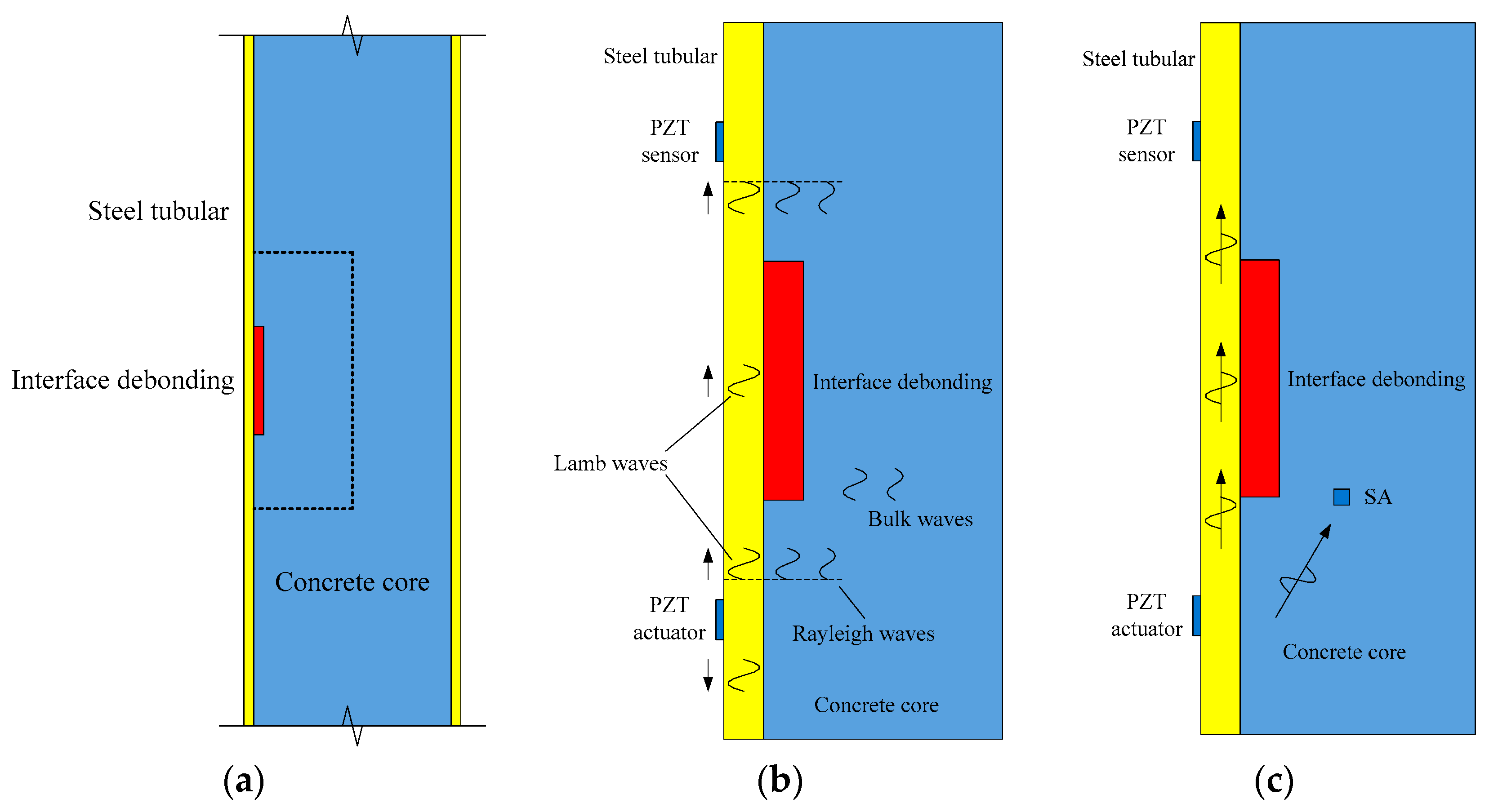



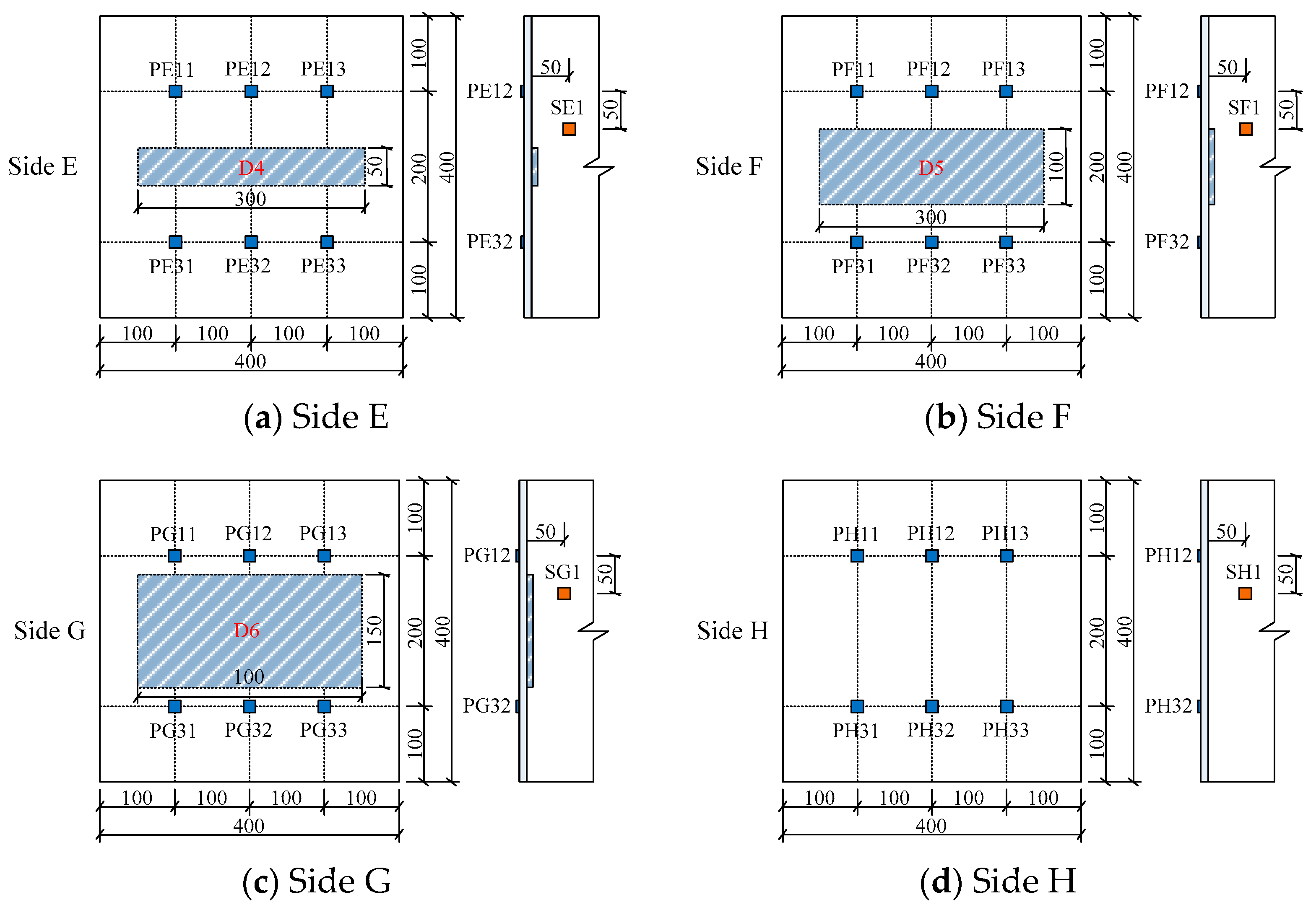
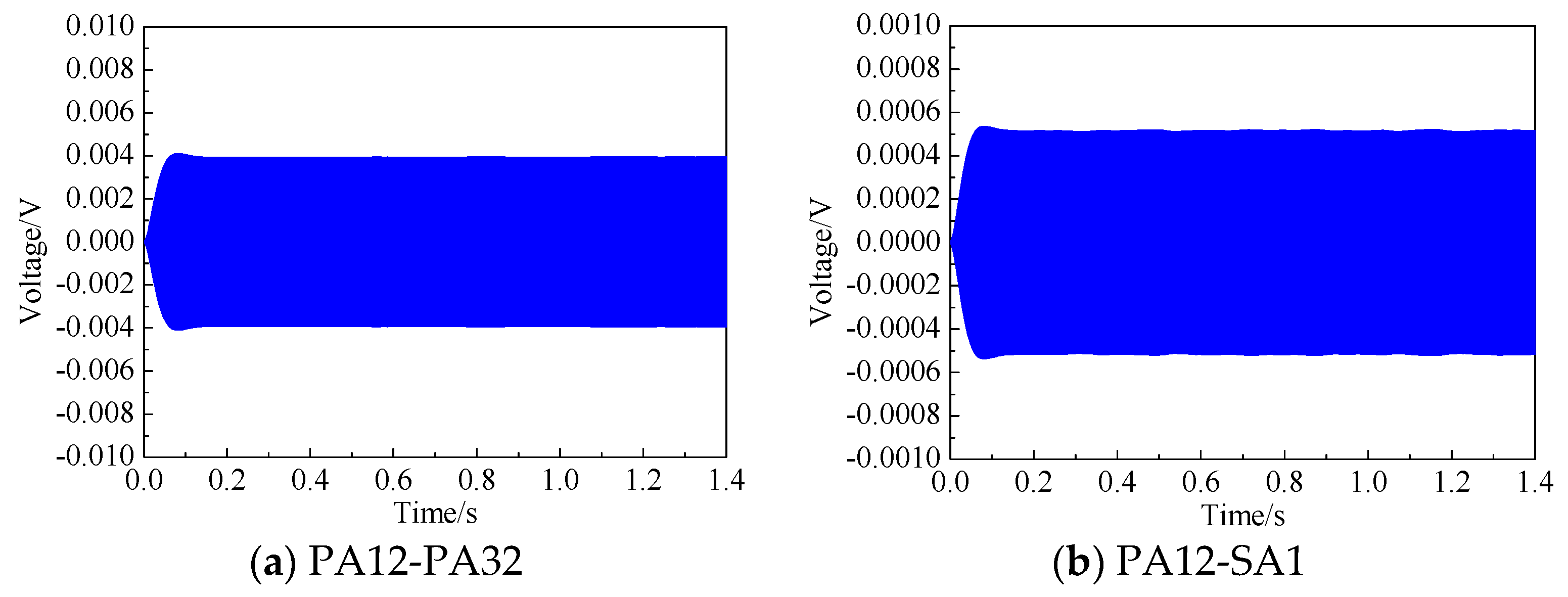
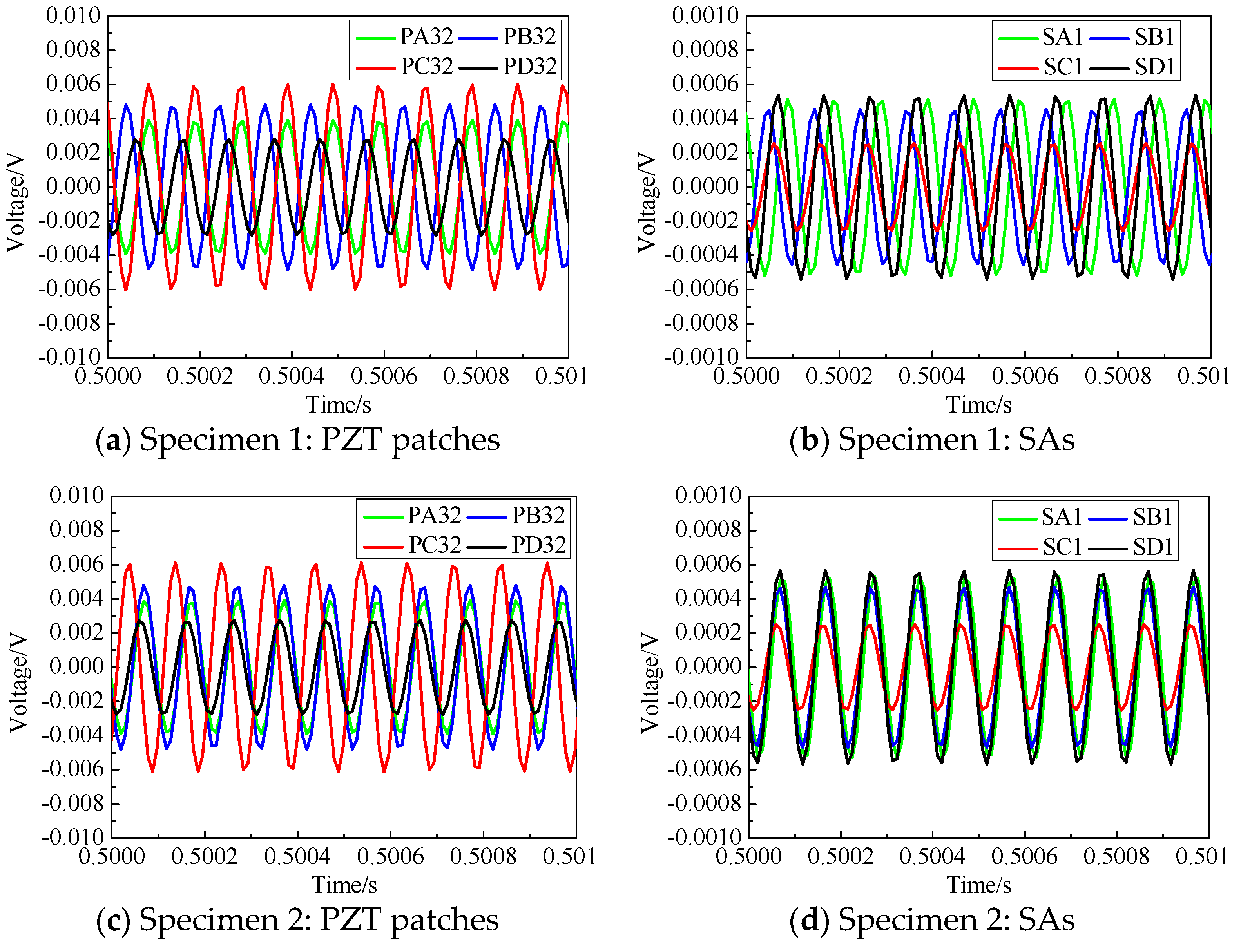
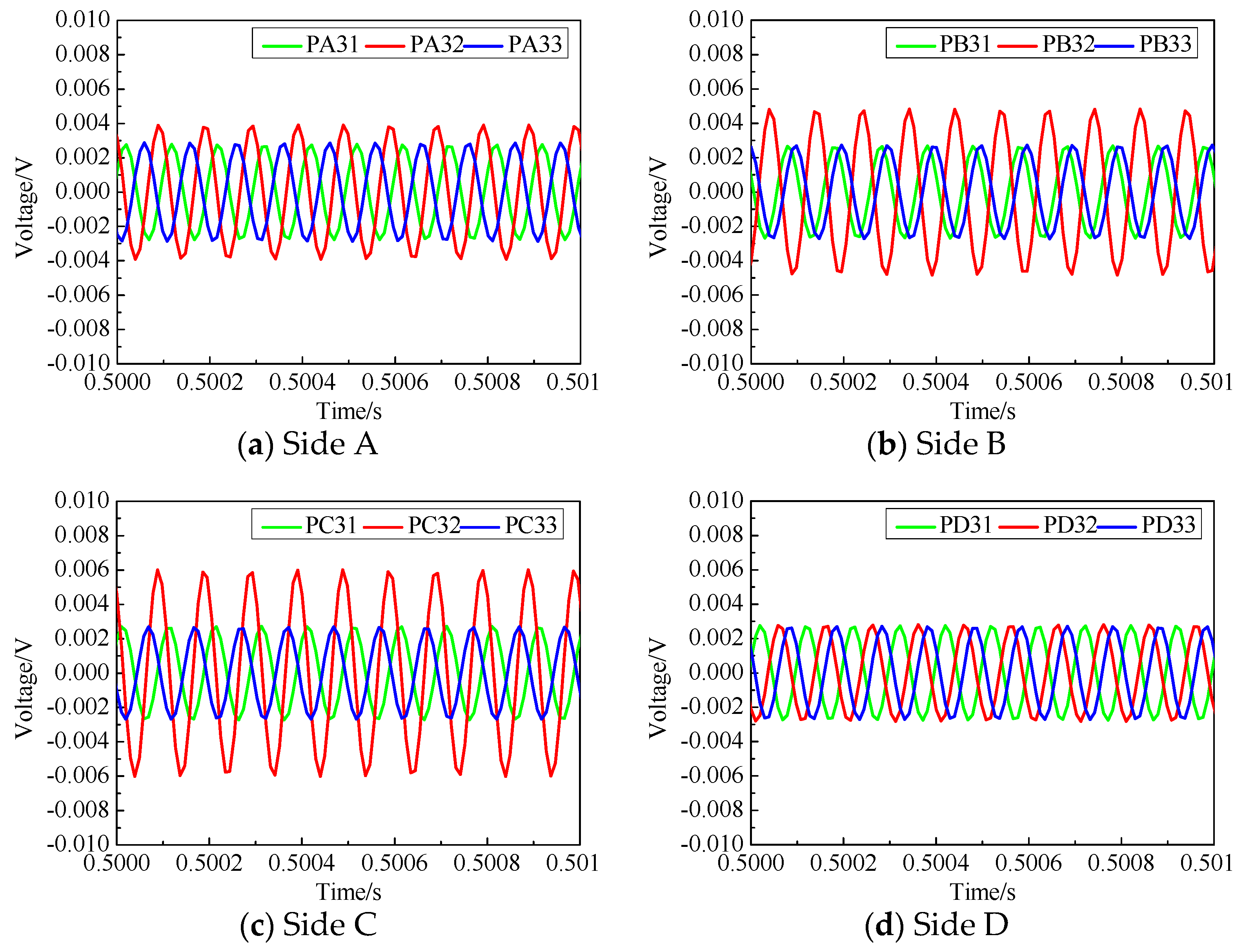

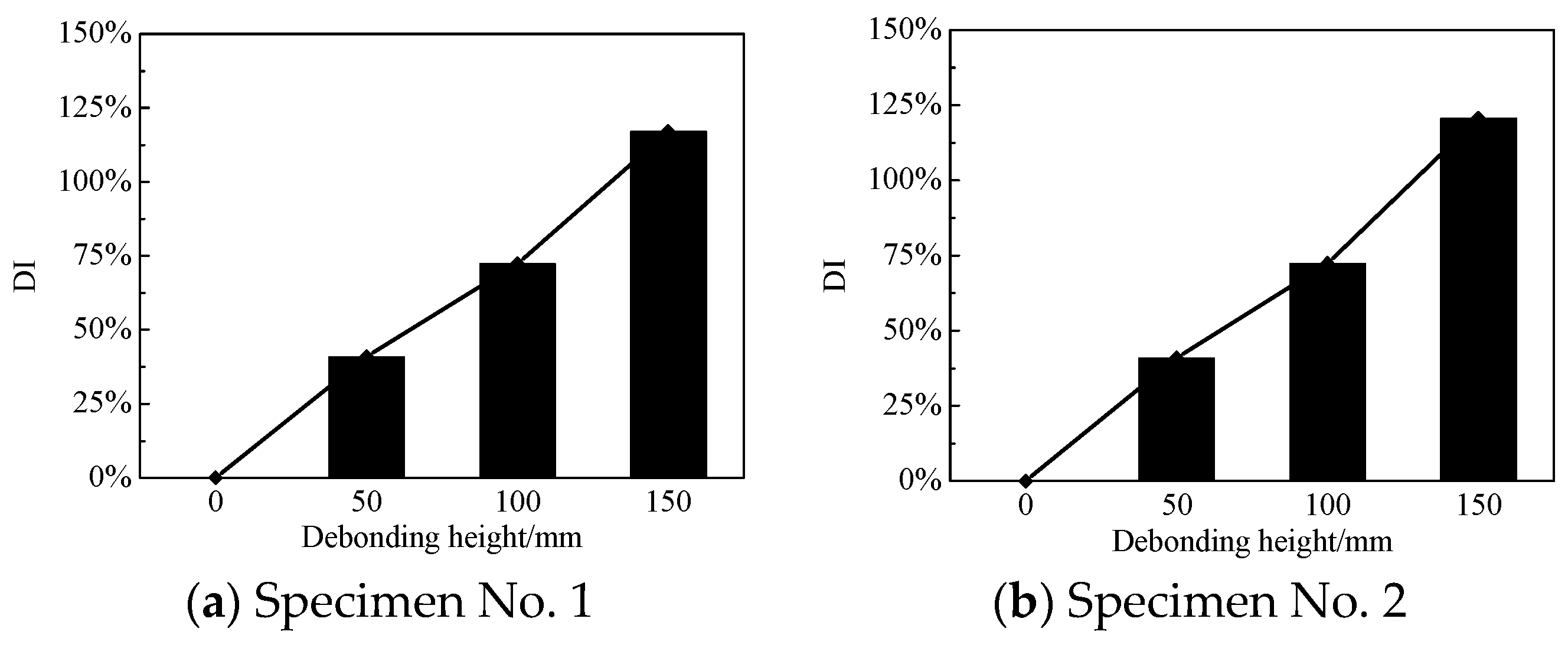

 | Debonding Defect No. | Width (mm) | Height (mm) |
| D1 | 100 | 50 | |
| D2 | 100 | 100 | |
| D3 | 100 | 150 | |
| D4 | 300 | 50 | |
| D5 | 300 | 100 | |
| D6 | 300 | 150 |
© 2019 by the authors. Licensee MDPI, Basel, Switzerland. This article is an open access article distributed under the terms and conditions of the Creative Commons Attribution (CC BY) license (http://creativecommons.org/licenses/by/4.0/).
Share and Cite
Xu, B.; Luan, L.; Chen, H.; Wang, J.; Zheng, W. Experimental Study on Active Interface Debonding Detection for Rectangular Concrete-Filled Steel Tubes with Surface Wave Measurement. Sensors 2019, 19, 3248. https://doi.org/10.3390/s19153248
Xu B, Luan L, Chen H, Wang J, Zheng W. Experimental Study on Active Interface Debonding Detection for Rectangular Concrete-Filled Steel Tubes with Surface Wave Measurement. Sensors. 2019; 19(15):3248. https://doi.org/10.3390/s19153248
Chicago/Turabian StyleXu, Bin, Lele Luan, Hongbing Chen, Jiang Wang, and Wenting Zheng. 2019. "Experimental Study on Active Interface Debonding Detection for Rectangular Concrete-Filled Steel Tubes with Surface Wave Measurement" Sensors 19, no. 15: 3248. https://doi.org/10.3390/s19153248
APA StyleXu, B., Luan, L., Chen, H., Wang, J., & Zheng, W. (2019). Experimental Study on Active Interface Debonding Detection for Rectangular Concrete-Filled Steel Tubes with Surface Wave Measurement. Sensors, 19(15), 3248. https://doi.org/10.3390/s19153248






